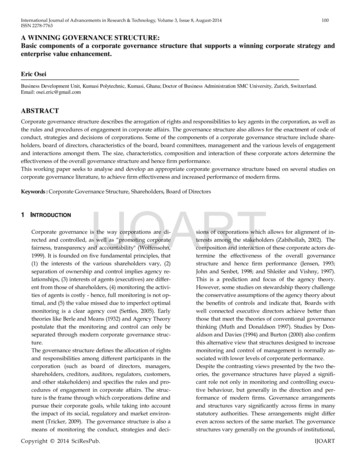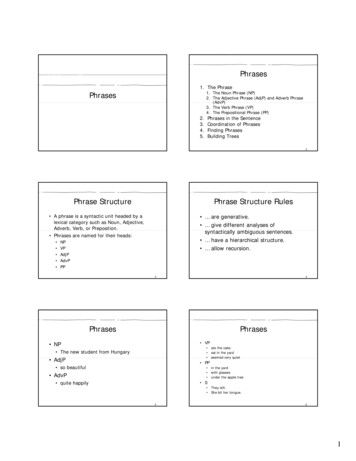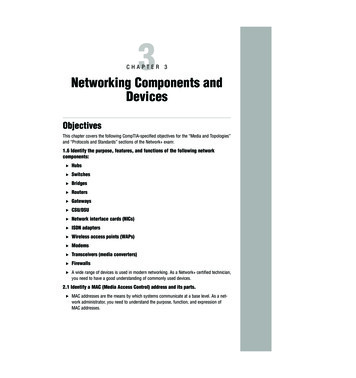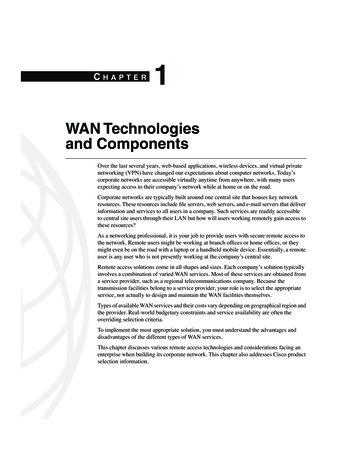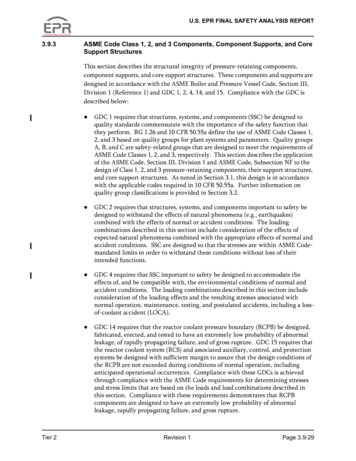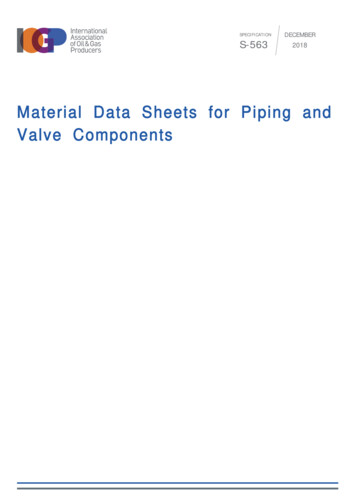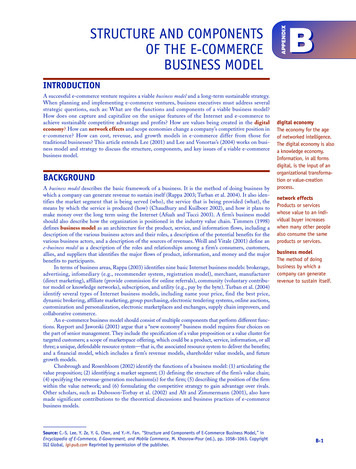
Transcription
APPENDIXSTRUCTURE AND COMPONENTSOF THE E-COMMERCEBUSINESS MODELBINTRODUCTIONA successful e-commerce venture requires a viable business model and a long-term sustainable strategy.When planning and implementing e-commerce ventures, business executives must address severalstrategic questions, such as: What are the functions and components of a viable business model?How does one capture and capitalize on the unique features of the Internet and e-commerce toachieve sustainable competitive advantage and profits? How are values being created in the digitaleconomy? How can network effects and scope economies change a company’s competitive position ine-commerce? How can cost, revenue, and growth models in e-commerce differ from those fortraditional businesses? This article extends Lee (2001) and Lee and Vonortas’s (2004) works on business model and strategy to discuss the structure, components, and key issues of a viable e-commercebusiness model.BACKGROUNDA business model describes the basic framework of a business. It is the method of doing business bywhich a company can generate revenue to sustain itself (Rappa 2003; Turban et al. 2004). It also identifies the market segment that is being served (who), the service that is being provided (what), themeans by which the service is produced (how) (Chaudhury and Kuilboer 2002), and how it plans tomake money over the long term using the Internet (Afuah and Tucci 2003). A firm’s business modelshould also describe how the organization is positioned in the industry value chain. Timmers (1998)defines business model as an architecture for the product, service, and information flows, including adescription of the various business actors and their roles, a description of the potential benefits for thevarious business actors, and a description of the sources of revenues. Weill and Vitale (2001) define ane-business model as a description of the roles and relationships among a firm’s consumers, customers,allies, and suppliers that identifies the major flows of product, information, and money and the majorbenefits to participants.In terms of business areas, Rappa (2003) identifies nine basic Internet business models: brokerage,advertising, infomediary (e.g., recommender system, registration model), merchant, manufacturer(direct marketing), affiliate (provide commission for online referrals), community (voluntary contributor model or knowledge networks), subscription, and utility (e.g., pay by the byte). Turban et al. (2004)identify several types of Internet business models, including name your price, find the best price,dynamic brokering, affiliate marketing, group purchasing, electronic tendering systems, online auctions,customization and personalization, electronic marketplaces and exchanges, supply chain improvers, andcollaborative commerce.An e-commerce business model should consist of multiple components that perform different functions. Rayport and Jaworski (2001) argue that a “new economy” business model requires four choices onthe part of senior management. They include the specification of a value proposition or a value cluster fortargeted customers; a scope of marketspace offering, which could be a product, service, information, or allthree; a unique, defendable resource system—that is, the associated resource system to deliver the benefits;and a financial model, which includes a firm’s revenue models, shareholder value models, and futuregrowth models.Chesbrough and Rosenbloom (2002) identify the functions of a business model: (1) articulating thevalue proposition; (2) identifying a market segment; (3) defining the structure of the firm’s value chain;(4) specifying the revenue-generation mechanisms(s) for the firm; (5) describing the position of the firmwithin the value network; and (6) formulating the competitive strategy to gain advantage over rivals.Other scholars, such as Dubosson-Torbay et al. (2002) and Alt and Zimmermann (2001), also havemade significant contributions to the theoretical discussions and business practices of e-commercebusiness models.Source: C.-S. Lee, Y. Ze, Y. G. Chen, and Y.-H. Fan. “Structure and Components of E-Commerce Business Model,” inEncyclopedia of E-Commerce, E-Government, and Mobile Commerce, M. Khosrow-Pour (ed.), pp. 1058–1063. CopyrightIGI Global, igi-pub.com Reprinted by permission of the publisher.digital economyThe economy for the ageof networked intelligence.The digital economy is alsoa knowledge economy.Information, in all formsdigital, is the input of anorganizational transformation or value-creationprocess.network effectsProducts or serviceswhose value to an individual buyer increaseswhen many other peoplealso consume the sameproducts or services.business modelThe method of doingbusiness by which acompany can generaterevenue to sustain itself.B-1
B-2Appendix B: Structure and Components of the E-Commerce Business ModelMAJOR COMPONENTS AND KEY ISSUES OF AN E-COMMERCEBUSINESS MODELIn order to sustain a successful business venture, a viable business model should address a number of issuesand the dynamics of the respective elements, including what value to offer customers (strategic goals andvalue proposition), which customers to provide the value to (scope of offerings), what capabilities areneeded to build a successful and unique resource system, how to price the products or services and generate streams of revenues, how to increase the scale and the scope of the venture, and what strategies andprocesses are needed to build and sustain a successful e-commerce business model.STRUCTURE AND COMPONENTS OF A VIABLE E-COMMERCEBUSINESS MODELExhibit B.1 identifies the major components of and several key issues affecting a viable e-commerce business model. It can be used to assist business executives and entrepreneurs in planning and implementinge-commerce business ventures. It also serves as a basic framework for further study of the e-commercebusiness model and strategy.VALUE CREATION IN E-COMMERCEIn the physical or traditional industrial economy, the inputs to a value-creation process are the raw materials or the necessary physical inputs that are required to produce the finished products or services.Outputs are finished goods or intermediate goods used as inputs to the subsequent downstream valuecreation processes. In the value-creation process, information serves as a supporting element. Information,such as design and engineering know-how, as well as production methods and procedures, is applied tofacilitate the “physical” transformation process, which involves one or more of the four value-adding activities describe in Meredith and Schaffer (1999): inspect, alter, transport, and store. Under this paradigm,management’s main focus is to make the transformation process more efficient.In contrast, input to the value-creation process in the digital economy (Tapscott 1996) is information(e.g., customer information or digital assets, and the status of production and distribution process) thatfirms gather, organize, select, synthesize, and distribute (Rayport and Sviokla 1995) in the transformationprocess to provide individual customers a customized solution. In the digital economy, information is asource of value, and every business is an information business (Earl 1999). Organizations in the DigitalEconomy should understand and be able to apply the concept and practice of virtual value chain (Rayportand Sviokla 1995) to create value and to generate new business opportunities. Because physical and digitaleconomies coexist within a firm and across an industry supply chain, business executives must go beyondfocusing on improving the transformation process itself to concentrate on leveraging information assets andcapitalizing on the unique features of e-commerce and the Internet to create more value for the customers.FIVE STEPS TOWARD E-COMMERCE SUCCESSLee (2001) proposes five essential steps toward e-commerce success. First, companies must redefine theircompetitive advantage in the Digital Economy, because e-commerce is changing the basis of competition.Business executives must redefine their competitive advantages in terms of cost, differentiation, marketing, and distribution. For example, Compaq built the best retail-distribution network in the computerindustry in the 1990s but was unable to compete with Dell’s “fast and light” direct-sales approach enabledby Internet technology (Browning and Reiss 1999).Second, companies must rethink the traditional ways of formulating business strategy. Executivesmust generalize thinking beyond building a Web site to designing an architecture that will support thecompany’s e-commerce strategy. They must take a comprehensive look at how their companies can focus ofan investment behind a single winning strategy that makes it easy for customers to do business with them.For example, Edmunds.com offers customers assistance throughout the automobile-purchase process.Third, business executives must reexamine the traditional business and revenue models. For example,information itself is a source of value and presents opportunities to develop new relationships with customers at very low cost (e.g., UPS and FedEx). It also presents opportunities to create new services and toimprove internal efficiency (e.g., Boeing’s intranet).Fourth, companies must reengineer the organization structures and processes to capitalize on the benefits of e-commerce. For example, to implement a customer-centered e-commerce model, a company needs tointegrate its suppliers, back-office functions, and front-office functions in order to achieve the organizationalflexibility necessary to move at Internet speed and to satisfy customer demand. Finally, companies must beable to reinvent customer services by building cost-effective total experience and loyalty-enhancing relationships with the most profitable customers. Companies can involve customers in the product developmentprocess through initiating technology-facilitated dialogue. In addition, companies can gather knowledge
Appendix B: Structure and Components of the E-Commerce Business ModelEXHIBIT B.1B-3Components and Key Issues of the E-CommerceBusiness ModelComponentElementKey IssueValue propositionsChoice of focal customer benefits Core products/services: What value or benefit do we provide for ourcustomers? How unique is the value or benefit? Do those values satisfy customer’s demand? Do the products or services have strong networkeffects? Are there substitutes for our products or services? Supplement products/services: How important are the supplement productsor services? How do we increase customer value by improvingor redesigning business processes? How important is it to provide product instructions, user training, and customer services? Market attractiveness: How substantial is the market segment? Is the market under- or overserved? What is the growth rate of the market segment? Which stage is the product in the product lifecycle? Intensity of market competition: What is the market or industry structure? How intense is the competition? How large are the entry and exit barriers? Prepurchase: How do we make it easy for customers to obtainand compare product- or service-relatedinformation? How important is the advertising to inform orpersuade customers to make the purchase? Do we need to obtain a third-party certificate orverification (e.g., VeriSign) in order to build atrust relationship with our customers? Purchase: When, where, and how do customers make thepurchase? What kinds of service are required to assistcustomers in purchasing the product or service? Is the delivery of products or services efficient? Postpurchase: Do we understand customer’s evaluation andsatisfaction of the product or service? Do the majority of the customers make repeatpurchases? Purchasing process: How important is it to offer customer assistance inthe whole process of purchasing a product? Can we identify the customer decision process andbe able to provide effective assistance?(continued)Target segmentScope of offeringsCustomer decision process
B-4Appendix B: Structure and Components of the E-Commerce Business ModelEXHIBIT B.1 (continued) Do we have an effectivee-commerce site that isuser friendly? How do we lower thetransaction costs to makeit easy for customersto do business with us?Product or service contents Unique resource systemResources and capabilitiesCore product or service: Do we understand whichbusiness we are in? Do our products orservices solve thecustomers’ problems?Supplementary productor service: Do we build and maintaina set of digital assetsin order to know ourcustomers better? How do we leverage on asingle set of digital assetsto provide value acrossmany different anddisparate markets? How do we increasecustomers’ switchingcosts from using ourcompany’s products orservices?transaction costsCosts associated withcontractual relationships in a marketeconomy; that is, coststhat the consumer orthe producer pays tomake the market transaction happen.digital assetsThe information (indigital form) a company collected aboutits customers.Companies that createvalue with digitalassets may be able toreharvest them througha potentially infinitenumber of transactions.switching costsRefers to costsincurred by buyerswhen they switch to adifferent supplier.economies of scopeSupply-side economiesof scope—Cost of thejoint production of twoor more products canbe less than the costof producing them separately. Demand-sideeconomies of scope—Asingle set of digitalassets can providevalue for customersacross many differentand disparate markets. Core delivery process: Do we understand andtake advantage of theeconomies of scope inproduction and distributionof the product or service? What kinds of channel(digital and/or physical)do we need to deliver ourproducts or services? How efficient and effectiveare the products or servicesbeing delivered? Specifying a resource system: Do we identify the resources (e.g., labor, capital,assets) needed to build our core competencies orcapabilities? Do we have all the necessary core capabilities tosupport our scope of product or service offerings? Do we need to outsource and/or partner with othersto gain missing capabilities? Can we identify key players who can fill out themissing capabilities?(continued)
Appendix B: Structure and Components of the E-Commerce Business ModelB-5EXHIBIT B.1 (continued) How important is the role of intellectual propertyrights (e.g., patents and trademarks) in buildingcapabilities?Logistics and delivery systemsRevenue and growthmodelsRevenue models Assessing the quality of the resource system: How unique is our resource system? How difficult is it for competitors to imitate oursystem? Do each of the capabilities support the delivery of acustomer benefit? How well do the capabilities complement andsupport each other? Are the specific resources mutually reinforcing?Are they complementary? Does the online resource system support the offlinesystem? Integration: Can we deliver a unique customer experiencethrough e-commerce? Are we able to achieve supply chain integration andsynchronization (e.g., applying Internet-basedcollaborative planning, forecasting, andreplenishment, CPFR)? Are we able to collaborate with business partnersacross a common technical platform using commone-business applications? Fulfillment: Can we match the performance of the physicalactivities to the virtual world? Can we develop a flexible and reliable channel toreach the end customers? Can we radically reduce the order-to-delivery timeto customers? Product/service sales: Are our revenues primarily deriving from productsales or from complementary products or services? Can we generate revenues from utilizing intellectualproperties? E-commerce-related revenues: How do we identify new sources of revenues frome-commerce (e.g., advertising, referrals, subscription,membership, commissions, transactions, etc.)? How do we use information to create value bothonline and offline (e.g., FedEx’s packaging trackingsystem)? How do we develop cross-selling opportunities toachieve synergy? Do our customers value the benefit of one-stopshopping? Pricing: How do we test prices, segment customers, andadjust to changes in supply and demand in realtime?(continued)
B-6Appendix B: Structure and Components of the E-Commerce Business ModelEXHIBIT B.1 (continued) How do we analyze digital assets and experimentwith new ways of pricing? Are we able to implement innovative e-commercepricing methods (e.g., reverse auction, one-to-onebargaining)? How do we build online brand equity to enhanceloyalty and to reduce price sensitivity?Financial growth modelsCompetitive strategy Growth strategy: How should we develop new revenue growth(e.g., deeper penetration into the current market,new product development, new marketdevelopment, and/or completely new productsand markets)? Growth model: Do we need to spin off an online division toestablish a new company? Do we need to establish strategic alliances or mergewith other online/offline companies?Value chain positioning Value system or network Where do we position our products or services in anindustry value chain? Can we integrate or moveupstream or downstream to increase added values? How do we create value? Do we create customervalue as a partner in a supply chain (e.g., manufactureror retailer), as a value shop (e.g., professionalservice), or as a central player of a network (e.g.,intermediary service)? Can we join a businessbusiness ecosystemecosystem (Gossain andA system in which comKandiah 1998) (e.g.,panies work cooperaonline mega sites such astively and competitivelyAmazon.com) as a member to support new prodto provide products oructs, satisfy customers,services to the finaland create the nextcustomers?round of innovation inGeneric Strategy Competitive advantage:key market segments. Do we have advantages over our competitors interms of marketing, cost structure, and product orservice differentiation? Do e-commerce and the Internet redefine thecompetitive advantage in the market or industrywe are in? Generic strategy: Which strategy should we pursue in order to sustainour competitive advantages (e.g., increase entrybarriers or block strategy, innovation or run strategy,and/or alliance or team-up strategy)?
Appendix B: Structure and Components of the E-Commerce Business ModelB-7about their customers by building and controlling a comprehensive customer database (i.e., digital assets).For example, mega retailing sites such as Amazon.com, Yahoo!, and eBay are able to redefine economies ofscope by drawing on a single set of digital assets to provide value across many different and disparate marketsto maximize customer value.FUTURE TRENDSBusiness models are largely believed to determine the success of an e-commerce venture. Alt andZimmermann (2001) argue that business models are perhaps the most discussed and least understoodarea of e-business. Business scholars have been conducting research in the e-commerce business modelfor more than a decade to assist business executives and entrepreneurs in formulating and implementing innovative business models. We now have a much better understanding of the taxonomy, components, and architecture of business models. Future research on the analysis, design, development, implementation, and controlling of the e-commerce business model include, but are not limited to, thefollowing areas: Innovation in the e-commerce business model and the continuing business model innovation processto achieve competitive advantage Convergence of strategy and business model Models and modeling techniques of e-commerce business models Trust-building in the e-commerce business model Sustainable business models for services, digital contents, mobile commerce, collaborative commerce,and peer-to-peer architecture Other specific industry perspectives on imple
ness model and strategy to discuss the structure, components, and key issues of a viable e-commerce business model. BACKGROUND A business modeldescribes the basic framework of a business. It is the method of doing business by which a company can generate revenue to sustain itself (Rappa 2003; Turban et al. 2004). It also iden-File Size: 446KBPage Count: 8
